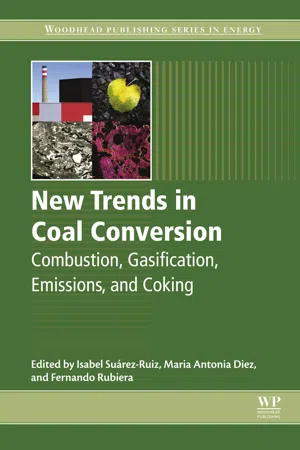
New Trends in Coal Conversion
Combustion, Gasification, Emissions, and Coking
- 542 pages
- English
- ePUB (mobile friendly)
- Available on iOS & Android
New Trends in Coal Conversion
Combustion, Gasification, Emissions, and Coking
About this book
New Trends in Coal Conversion: Combustion, Gasification, Emissions, and Coking covers the latest advancements in coal utilization, including coal conversion processes and mitigation of environmental impacts, providing an up-to-date source of information for a cleaner and more environmentally friendly use of coal, with a particular emphasis on the two biggest users of coal—utilities and the steel industry. Coverage includes recent advances in combustion co-firing, gasification, and on the minimization of trace element and CO2 emissions that is ideal for plant engineers, researchers, and quality control engineers in electric utilities and steelmaking.Other sections cover new advances in clean coal technologies for the steel industry, technological advances in conventional by-products, the heat-recovery/non-recovering cokemaking process, and the increasing use of low-quality coals in coking blends. Readers will learn how to make more effective use of coal resources, deliver higher productivity, save energy and reduce the environmental impact of their coal utilization.- Provides the current state-of-the-art and ongoing activities within coal conversion processes, with an emphasis on emerging technologies for the reduction of CO2 and trace elements- Discusses innovations in cokemaking for improved efficiency, energy savings and reduced environmental impact- Include case studies and examples throughout the book
Frequently asked questions
- Essential is ideal for learners and professionals who enjoy exploring a wide range of subjects. Access the Essential Library with 800,000+ trusted titles and best-sellers across business, personal growth, and the humanities. Includes unlimited reading time and Standard Read Aloud voice.
- Complete: Perfect for advanced learners and researchers needing full, unrestricted access. Unlock 1.4M+ books across hundreds of subjects, including academic and specialized titles. The Complete Plan also includes advanced features like Premium Read Aloud and Research Assistant.
Please note we cannot support devices running on iOS 13 and Android 7 or earlier. Learn more about using the app.
Information
Coal
Abstract
Keywords
1.1. Introduction
1.2. General concepts about coal
1.2.1. Coal definition
Table of contents
- Cover image
- Title page
- Table of Contents
- Related titles
- Copyright
- List of contributors
- Biographies
- Preface
- Acknowledgments
- 1. Coal
- 2. Current status of CO2 capture from coal facilities
- 3. Minimization of Hg and trace elements during coal combustion and gasification processes
- 4. Coal and biomass cofiring: CFD modeling
- 5. Coal and biomass cofiring: fundamentals and future trends
- 6. Technologies for control of sulfur and nitrogen compounds and particulates in coal combustion and gasification
- 7. Current status of coal gasification
- 8. Industrial perspective of the cokemaking technologies
- 9. Coke tumbler strength prediction from measurements of the plastic layer
- 10. Nonrecovery and Heat recovery cokemaking technology
- 11. Compacting of coals in cokemaking
- 12. The development of cokemaking technology based on the utilization of semisoft coking coals
- 13. Coke in the iron and steel industry
- 14. Coal-based reducing agents in ferroalloys and silicon production
- 15. Coal tar: a by-product in cokemaking and an essential raw material in carbochemistry
- Index